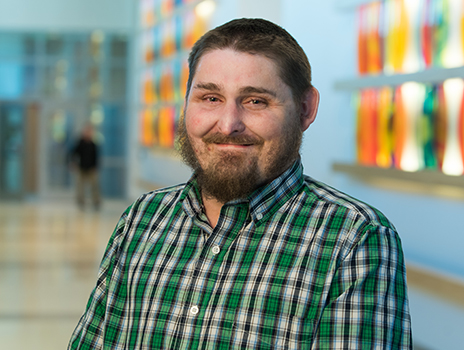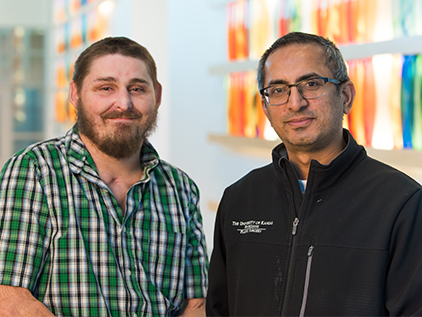Burn Care Enables a Positive Outcome


Justin Taylor adores his children, Alana, 11, Carter, 8, and Arabella, 1. When he looks at Arabella, he sees the beautiful baby girl she is, but also something more. He sees a new beginning and a hopeful chapter following a harrowing ordeal.
In August 2015, Justin nearly lost his life in an explosion in his home. He was handling a butane lighter when a nearby electrical outlet threw sparks. The combination proved almost deadly as the resulting explosion caused burns to 70% of Justin's body, along with respiratory damage from smoke inhalation.
When the ambulance arrived, Justin was barely conscious, but he recalls a thread of the emergency response team's conversation.
"There was talk of taking me to the nearest community hospital, but I heard someone say, 'No. He won't survive if we don't take him straight to The University of Kansas Hospital."
The hospital, part of The University of Kansas Health System, offers the Gene and Barbara Burnett Burn Center, the area's only adult and pediatric burn care facility accredited by the American Burn Association and American College of Surgeons. The program earns this certification – for which it is fully reassessed every 3 years – for its seamless coordination of care across disciplines and resources dedicated to burn care 24/7.
"We are the area's only verified burn center," says burn and wound care surgeon Dhaval Bhavsar, MD, co-director of the burn center. "That is a mark of distinction for our patients, their families, our community and our payers. We provide the highest quality of care and resources for our patients, not just while they're in the hospital, but throughout their complete recovery."
Under Dr. Bhavsar's direction, Justin received inpatient burn treatment until mid-November. This included hand therapy that began within 24 hours of his admission.
"He had very severe burns," says Janelle Epp, occupational therapist for the health system. "For some time, he was intubated and sedated. During this period, we focused on positioning, splinting and passive range of motion to reduce edema and prevent contractures. We progressed to active motion and attempting use of his arms as he improved. We needed to keep his joints moving while he healed, including after skin grafting. It was our goal to get him as independent as possible before he went home or to rehab."
I heard someone say, 'No. He won't survive if we don't take him straight to The University of Kansas Hospital.' – Justin Moore
Hypersensitivity to pain and complications from infections prevented Justin from progressing as quickly as he and his providers hoped he would. Upon transfer to inpatient rehabilitation, he remained reliant on others to perform daily functions, such as eating and brushing his teeth.
He spent a month there, a timeframe in which the tables turned. He progressed rapidly from complete dependence to requiring only minimal assistance for self-care.
"Justin's wife, Amanda, was highly supportive and a very calming influence," says Mary Schwartz, Justin's occupational therapist. "She could motivate him like no one else, so we taught her to support his care and involved her in the process. He needed a gradual, gentle pushing approach. He made really excellent gains during his time here."
"We work as a collaborative therapy team here, and this approach is truly helpful to both patients and therapists," says Amber Driskell, Justin's physical therapist. "Justin came to know us and what we expected, and as we bonded, he worked harder. He saw that we weren't going to give up on him, and I think that helped him decide not to give up on himself. He found his inner strength."
Because of the support Amanda could provide, Justin was able to return home after a month of rehab. The care team knew that she could offer the help he needed, but that she would also push Justin to help himself.
"Once home, Justin continued to push himself to achieve, and he is a stronger person today," Epp says. "He endured days and months of pain. I am very impressed with how far he was eventually able to go once he was mentally ready and focused."
Today, Justin is doing well, though he bears the scars of the explosion. He lost digits from his left hand and continues to have limited mobility in both hands. He recently completed a seasonal job picking apples and has taken a new one milking cows. It's much different from the construction work he used to do, but he's proud and grateful he has regained sufficient hand function to perform such tasks and make a financial contribution to his family – a family that now includes little Arabella.
"I feel so much better than I did a year ago, and so much better about myself," Justin says. "Throughout this ordeal, I received excellent care. The medical and nursing staff and therapists understood what I was going through. They became a second family."
Justin continues to seek the positive following what could have been a devastating event. He feels he is a mentally and physically stronger person today, with a greater appreciation for the important things in life, like spending time with his wife and children. He compliments the care he received at The University of Kansas Health System.
"I hope you never need it, but if you do, this is the only place to go for burn care," he says. "It is a great, caring team. They have more firsthand experience and know how than anyone. They treat the complete emotional, mental and physical needs of burn survivors. They are such an important resource and do their absolute best for everyone."

Since 1973, the Gene and Barbara Burnett Burn Center has served our community as greater Kansas City's only burn center accredited by the American Burn Association and the American College of Surgeons. Our specialty-trained care team helps patients like Justin overcome potentially devastating injuries and return to physical, mental and emotional health. With your support, we can do even more.